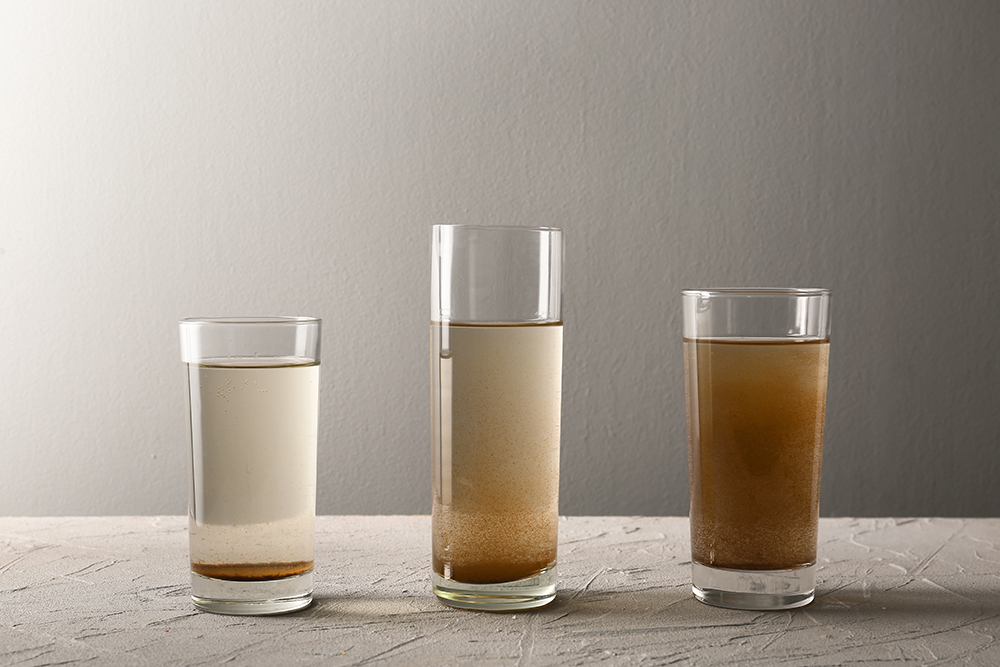Water from domestic wells often has a reputation of being either sparkling clean or full of unpleasant smells and tastes — and it’s true that there’s rarely a middle ground when it comes to well water quality.
Because wells are fed by water that’s spent long periods underground, any potential contaminants are mainly determined by the types of bedrock that water has traveled through.
Well water that travels through lots of porous, sedimentary bedrock such as sandstone is likely to contain a mix of different earth metals and minerals. Well water filtered by hard, igneous bedrock like granite, on the other hand, is likely to have a purer profile.
So what are the most common minerals, metals, and other contaminants found in domestic well water, and how can you remove them from your water supply? Let’s find out.
With so many potential contaminants, is well water safe?

source: allergyandair.com
It can be alarming to learn that, by the time your drinking water reaches your faucet, it’s spent long periods underground, collecting different types of contamination. When you hear of any substance dissolved into your water, it’s natural to ask whether your well water is safe to drink.
But the thing to remember here is that all water, regardless of source, contains a range of different contaminants. Even city water, which has passed all EPA health and safety guidelines, can contain a wide range of dissolved metals, minerals, and chemicals.
So the real question is not whether drinking water contains any contamination, but which contaminants — and how much. Only then should you invest in a well water filter.
The good news here is that well water is far less vulnerable to contamination with health risks than water sources from lakes, rivers, or reservoirs.This is because groundwater enjoys several layers of natural filtration before it reaches a domestic well. Soil, sand, silt, and bedrock rock all play a role in filtering groundwater to remove larger particles of contamination.
As a result, well water is much less likely to contain chemicals or microorganisms—two classes of contamination that often pose a greater health risk than earth metals and minerals.
Iron
Iron is one of the “big four” groundwater contaminants and is found in domestic wells across the country due to its prevalence in the surrounding earth.
You’ll know if your water contains undissolved iron from discoloration, metallic tastes, and smells, or highly visible orange stains that accumulate in sinks and bathtubs.
But iron can also exist in a dissolved form that has no identifiable taste, smell, or appearance. When dissolved iron is present in well water, it can still cause staining as well as promote the growth of bacteria that feed on iron-rich water.
How do I remove iron from my well water?

source: sciencenewsforstudents.org
Most water filtration experts recommend using an oxidizing filter to remove iron from well water.
These devices convert dissolved, soluble iron into an insoluble solid form that can be more easily screened from the water supply.
Sulfur
Like iron, sulfur is an abundant compound that naturally occurs in the earth. It can exist as a solid or as a gas in the form of hydrogen sulfide, which is made when organic matter breaks down in the soil.
Sulfur gas is easily identifiable due to its unpleasant odor, which is often likened to the smell of rotten eggs. In some cases, sulfur can also cause yellowish staining or fixtures and appliances.
How do I remove sulfur from my well water?

source: rightgroup.com
To reduce sulfur and fix rotten egg smells in well water, an oxidizing filter should again be the most effective type of water treatment. Because sulfur gas can be dissolved into the water supply, it can be difficult to screen out without an oxidation stage to convert sulfur into an insoluble form.
Sediment
Sand, dirt, rust, and silt are all classified as sediment, and can easily accumulate in domestic wells.
Sediment is often an issue in areas with sandstone bedrock and can be made worse by well pumps that are positioned too low inside a well shaft so that they draw up loose material from the floor.
You’ll notice high levels of sediment in your water supply if there’s cloudiness to your water, or if grit appears in toilet bowls. Sediment can also be responsible for shortening the lifespan of delicate appliances.
How do I remove sediment from my well water?

source: niehs.nih.gov
As this post on how to filter your well water recommends, any whole-house filtration system should include a sediment filter to help screen water for large particles and protect home plumbing.
Sediment filters use material screens with small pores that allow water through while catching small undissolved particles. Depending on the type of filter and screen, some sediment filters are able to capture microscopic particles as small as one micron (one-millionth of a meter).
Heavy Metals
Just like iron and sulfur can naturally find their way into groundwater, other heavier elements like lead and arsenic can also show up in well water.
Unlike the above contaminants, however, heavy metals do pose a risk to health if consumed. This means that they should always be filtered from the water supply, even if they’re only present in small amounts.
Heavy metals rarely have any taste, smell, or appearance, which is why it’s important to periodically test well water to check for pollutants.
How do I remove heavy metals from my well water?

source: pinterest.com
Reverse osmosis filters are frequently recommended for well water that contains health risks thanks to their impressive filtration capabilities.
By forcing water under pressure through micro-pore membranes, reverse osmosis filtration systems are able to process water on a molecular level, removing almost all known groundwater contaminants—including lead, arsenic, and other heavy metals.
Bacteria
When wells are correctly drilled and properly maintained, the risk of contamination from bacteria, viruses, or other microorganisms is very low. This is in contrast to surface water from lakes and rivers, which should always be disinfected to protect against living pathogens.
But well water isn’t immune to bacterial contamination. Shallow wells, aging well systems, and wells in flood-prone areas can become infected and become an environment that’s conducive to bacterial growth.
How do I remove bacteria from my well water?
Two of the most popular ways to disinfect well water contaminated with bacteria are chlorination and UV purification.
Chlorine is a ubiquitous water treatment method that’s been used for decades in municipal water. In private wells, chlorine is either added in small amounts using a timed feed pump or in a single large dose, usually administered once per year in what’s known as shock chlorination.
UV purifiers are a modern solution to bacterial infection. They work by shining a high-intensity light through the water supply to destroy microorganisms, rendering them harmless.



